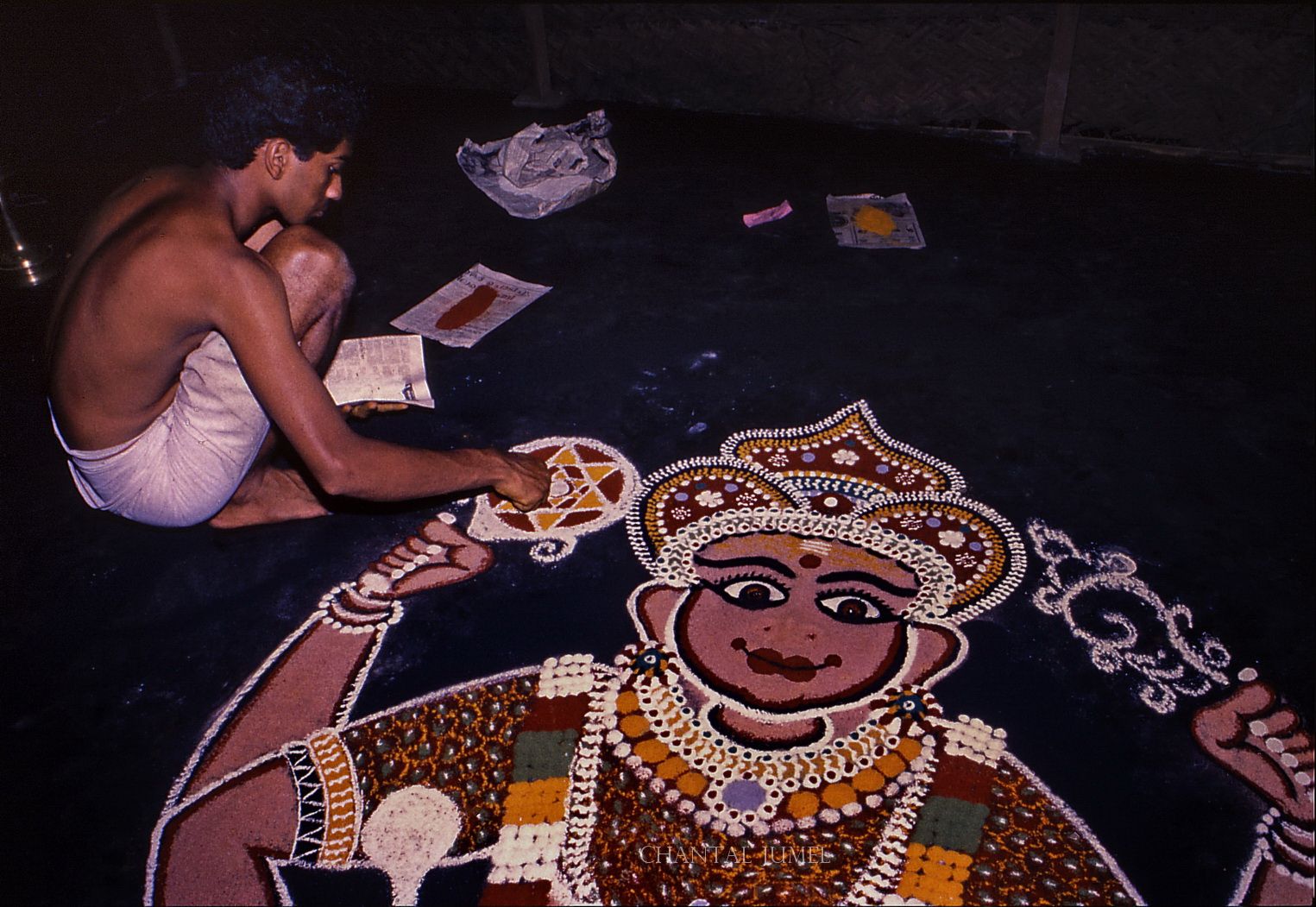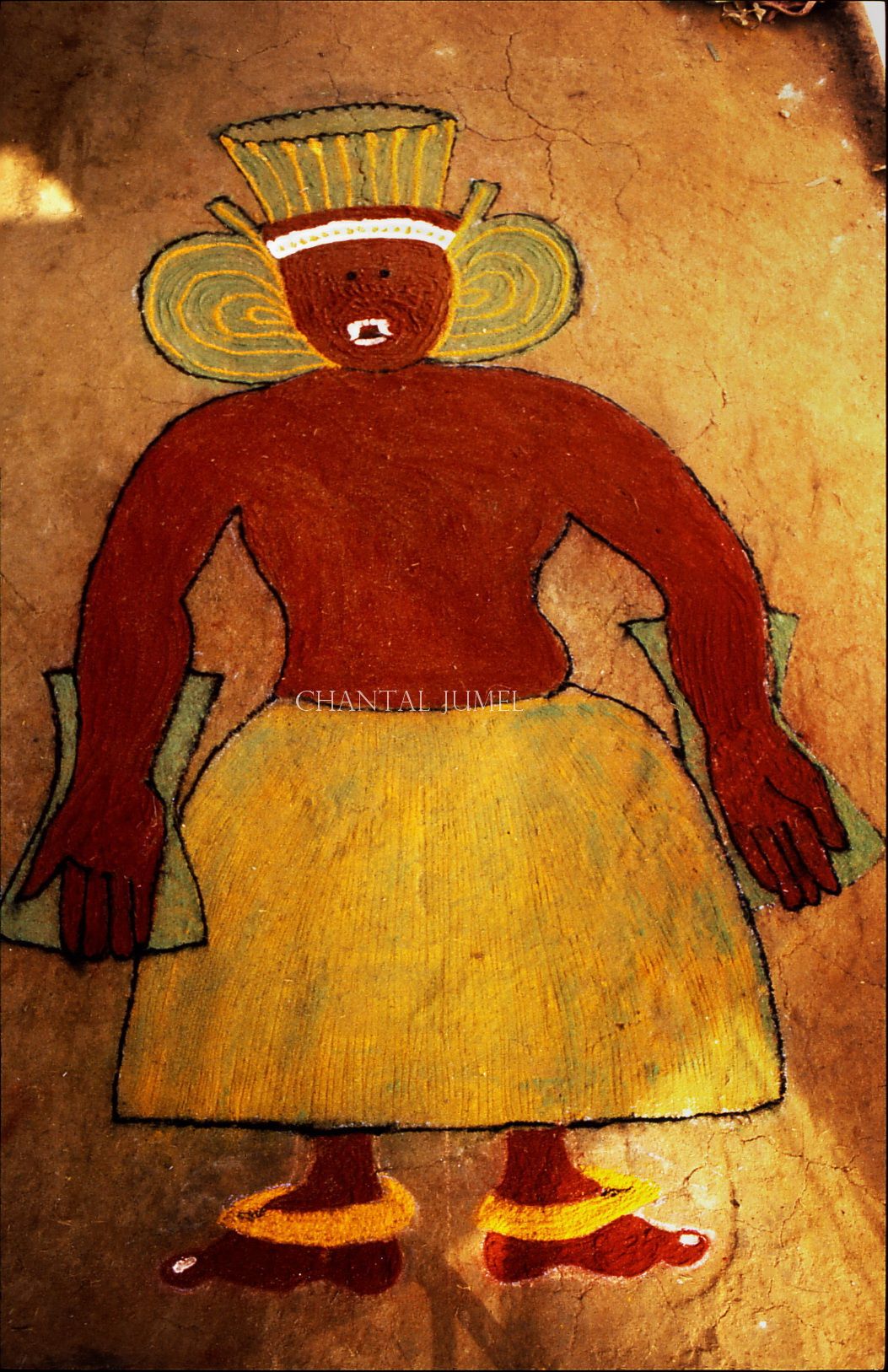Kerala Kalam, "Colours and emotions" — part 4
Panchavarnam, five colours for the kalam paintings are more than just an aesthetic choice; they convey concepts as well as feelings. The five powders are chosen according to the attributes of each god or goddess. The iconography refers to myths and legends.

Panchavarnam, five colours for the kalam
Colours are more than just an aesthetic choice; they convey concepts as well as feelings. The five powders are chosen according to the attributes of each god or goddess. The iconography refers to myths and legends and to the precepts memorised and handed down from generation to generation. The boys help their fathers, preparing and mixing the powders, observing the sketching and the filling up of areas with the appropriate colours, until they know enough to be able to draw the sacred body of the deity themselves. Panchavarnam (five colours) are either mineral or vegetal. In general, we find arippoti (rice powder) or chunnam (slaked lime) for white, manjal (pounded turmeric roots (Radix curcumae) for yellow, vaka (the pounded leaves of a certain acacia tree (Acacia sirisa) for green, a mixture of turmeric and slaked lime for a deep red and finally, burnt and pounded paddy husks for black. In floor paintings, the complexion of the gods and goddesses vary, depending on the qualities they display.
In southern India, GREEN is favoured over white to symbolise the qualities associated with nature: goodness, virtue, fertility and nobility, and the qualities representing the satvic (calm and sage-like) characters such as Bhadrakali and Ayyappan in his manifestation as the hunter. Intrinsically, this colour is perceived as a good omen in south Indian rituals.


YELLOW is the colour of the sun, of turmeric and of saffron. Note that the dried root of turmeric is ground into powder and is commonly used as a spice, especially in Tamil Nadu, and as a paste for women’s face, infants 'bodies, and cows on the day of Mattu Pongal.


Women often apply it to their faces on Friday so as to resemble Goddess Durga, whose skin emits a yellow glow. In Hinduism, because turmeric is associated with fertility and prosperity, it is used during wedding ceremonies. The powder is mixed with water to form a paste and family members apply it to the bride's and the groom’s faces and bodies. In the kalam tradition, it is used for Nagayaksi drawn by the Kuruppu, for Gandharva in a ritual called Kalampattum but also for terrifying deities like Chudalabhadra (goddess of the cremation ground) and Gandharva in Malayankettu. Orange-yellow suits Annapurneswari, a munificent form of the Goddess, and Ayyappan when he is portrayed as the lord of Sabarimala


RED is used for Rakta-Chamundi, Yaksi, Yaksa and Pillattini (the child devourer). This ambivalent colour connotes either blood, the symbol of life, good health and sexual energy, or symbolises the main cause of pollution in the body, such as menstruating women. The latter are proscribed from entering temples, the puja room (the room that houses the domestic shrine) and the kitchen, and are even forbidden from approaching the household well, generally situated in the front or back yard. Red is also considered a symbol of bodily impurities due to its association with bloodshed during wars, death or any obscure rituals involving sacrifices.



BLACK is used for evil deities and demons. Chthonian forces, black magic rites and pollution are associated with this colour. Here too, there is a contradiction, as the gods Krishna and Shiva have a dark complexion that would be the result of intense tapas (spiritual austerities).


Abhinaya, or the art of expressing emotions
According to the Natya Shastra, bhava is the psychological state and rasa its emanation or projection. If the body’s posture suggests the mental state, the shape of the eyes — according to canonical rules — immediately translates the emotion. It is important that the painter should perfectly translate the features of each and every divinity. The expression of human sentiments in kalam is strongly influenced by Kerala drama conventions like Kathakali and Kutiyattam. In India’s performing arts, nine emotions (NAVARASA) are evoked in the audience during dance, music or drama performances. SRINGARA (love, attraction), ADBHUTA (wonder), karuna (compassion or sadness), VIRA (courage, pride and nobility), HASYA (laughter, comedy), RUDRA (fury, violence), BHAYANAKA (fear, horror and terror), BIBHATSAM (disgust, aversion) and finally, SHANTA (peace and serenity). In kalam paintings, the feelings most commonly suggested are sringara and shanta for the serene aspects of the goddess and for Ayyappan as "the Lord of Sabarimala". The emotion vira suits Ayyappan as a hunter and rudra is suitable for expressing the cruelty of certain deities.




The article is a translated excerpt from my book : "Kolam et Kalam, peintures rituelles éphémères de l'Inde du Sud", Editions Geuthner, Paris 2010.
Previous articles
